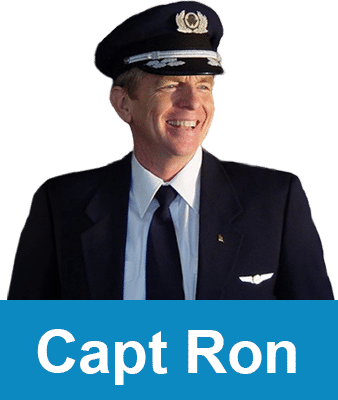Questions For The Capt

During our Cleared for Takeoff class, pilots Capt. Ron, Capt. John and Capt. Eric patiently answer many questions from fearful flyers. We don’t believe there are any silly or stupid questions. Fearful flyers truly wonder what goes on up there, and we’re always happy to answer all their questions.
Does fatigue effect Air Traffic Controllers?
(My sister is an Air Traffic Controller, so I felt particularly qualified to answer this question.)
The answer is yes! Fatigue effects everybody. We work, and we get tired. However, Air Traffic Controllers are protected by work rules that are similar to those that protect pilots and flight attendants. These rules are regularly reviewed by the Department of Transportation and are updated from time to time to better match the changing workplace environment.
Another fearful flyer was concerned about flying on a Regional Jet (RJ) or turboprop commuter aircraft.
Does a larger jet transport aircraft likely provide a smoother ride? Yes, it does. She asked how to determine what kind of airplane you will be flying on.
The answer was simple: View your chosen airline’s website prior to making the reservation or afterward, or call that airline’s reservations system and simply ask. This fearful flyer wanted to travel from Tucson, Arizona, to Burbank, California. I suggested that she fly on Southwest Airlines from Phoenix to Burbank directly. Southwest does not offer flights on any of the smaller regional aircraft. It’s worth mentioning that the smaller regional jet aircraft does take less time to board and deplane. Boarding is particularly stressful, at least to me, so sometimes a Regional Jet may be provide a better and more comfortable flight experience. Even better, though there are fewer seats and less space in the overhead cargo bins, there are no middle seats. Simply put, you won’t have more than one person sitting directly next to you! So there are good things about flying on these smaller planes if you’re not just concerned about the ride.
How do you avoid running into high things like mountains? Specifically, these mountains are near the Hoover Dam and border the southern edge of Lake Mead.
This a good question as those cactus-covered hills are impressive as the airplane is in a left hand turn toward the airport. In reality, those hills are at least two miles away from the flight path of the airplane. They are also approximately half a mile below the aircraft’s flight path. To be sure, the hills are impressive, but we pilots know exactly where they are and how to avoid them.
So how close is high terrain and how do pilots avoid it while flying in the clouds or in darkness?
No, it doesn’t involve good luck or magic! When pilots can see the mountains, hills or man-made obstacles, we can simply guide the airplane so that we don’t encounter them. This would be similar to driving your car and avoiding the neighbor’s mailbox or the parked cars on the side of the street. Self-preservation and common sense allow us to avoid stationary obstacles. In a car, our ability to predict the behavior of other drivers, along with the calculus and algebra that we use to gauge our position relative to the other moving vehicles, allow us to avoid most unplanned encounters. Airline flight removes virtually all of this guesswork and uncertainty.
Airline flight is done under Instrument Flight Rules, which we abbreviate as “IFR.” We have many acronyms in aviation, but this one represents an important safety foundation. Simply put, flight via the Instrument Flight Rules means that we don’t need to see where we are going to know where we are. We do this by following a specific flight path that is determined electronically. This electronic flight path was originally perfected for airline use in the late 1940s, when the airlines were still using government surplus piston-engine transport aircraft. Since then, many changes and updates have improved the aviation industry by making airline flight both far safer and much more efficient. Still, airline aircraft retain some very primitive navigation instrumentation. These old systems now supplement the new technology that is constantly improving.
What’s some of the new technology?
The navigation display of the modern airliner is highly sophisticated and shows the terrain in real time, to scale, and to relative elevation. Even better, these displays are combined graphically with our Enhanced Ground Proximity Warning System, or EGPWS, which directs radar both downward and forward, providing us with yet another layer of protection.
What this really means is that we guide the airplane via several different navigation systems. We fly only on established routes or via approved clearances. Our onboard database and onboard radar-based EGPWS is constantly looking for any high terrain that we may inadvertently encounter. And… Our Air Traffic Control system, staffed by the best controllers in the world, is constantly watching the progress of our flight. Separation of traffic is the primary task of the Air Traffic Controller. They, like pilots, are consummate professionals. (I know this first hand, as my sister is an Air Traffic Controller!)
Providing an additional layer of safety are the eyes of the pilots. The vast majority of our flying is during good weather and during the daytime. We can usually see the terrain and the other traffic. Both are quite distant from our airplane, even if they appear to be impressively close to us.
To summarize: As a passenger, you are in good hands. The people working in aviation are highly interested in your safety and well-being. We are extremely proud of the service that we provide. We want you to participate in, and eventually enjoy, the safest transportation system ever devised.

